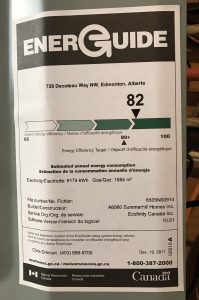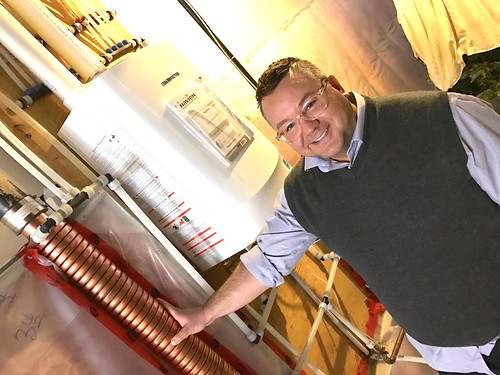By David Dodge & Dylan Thompson

The new EnerGuide label tells Mike Melross how much energy his home uses. His score came in at 69, about 32% better than a code built home. Photo David Dodge, GreenEnergyFutures.ca
Energy efficiency is the big missing link in determining the long-term cost of owning a home, much like when you buy a new car or fridge. There’s a reason we hear so much about miles per gallon. The big difference is your fridge already has an EnerGuide sticker and so does your car.
For example the purchase price of a new water heater represents only 12 per cent of the cost of owning and using a water heater. Fully 88 per cent of the costs are the energy costs of operating the appliance.
This is why it’s weird and unfortunate that we don’t put more emphasis on understanding how energy efficient our homes are.
Know what you’re buying

Mike Melross’ home came with an EnerGuide label in 2011. In the old system a score of EnerGuide 82 was above average whereas some net-zero homes are rated in excess of EnerGuide 86. Photo David Dodge, GreenEnergyFutures.ca
When Mike Melross went home-shopping, excellent energy efficiency was a must have. He bought a Landmark home in 2011, which had an EnerGuide label and a rating of 82 under the old EnerGuide system. This was well above a code-built home at the time.
But Melross isn’t a “code-built” kind of homebuyer. He works in the energy transition unit for the City of Edmonton and he’s involved with a program to significantly ramp up the use of EnerGuide labels in homes.
The city wants us all to reduce our emissions as a climate change mitigation strategy, but energy efficiency also make a lot of sense for us average home owners since it will reduce operating costs, make our homes more comfortable and help guard us against some inevitable future energy price increases and carbon levies.
As Melross explains, the EnerGuide labeling process is much more than a label.
“An energy advisor comes out, reviews all the components of your home, and does something called a ‘blower door test.’ That blower door test actually determines how many air exchanges per hour your home has,” says Melross. They check your insulation, your heating system, your appliance, light bulbs and they look for places that are sucking energy in your home.
The results “get put into a model, and the model will put out a rating for you home that says how many gigajoules that home will use under standard operating conditions,” says Melross.
If you are in Edmonton get an EnerGuide for Homes audit and receive a $400 rebate.
But it doesn’t end there. EnerGuide auditors will also produce “a renovation upgrade report – that is a personalized roadmap to energy efficiency for your home.”
In Mike’s home he already had a 97 per cent efficient furnace, a heat recovery ventilator (to pre heat fresh air coming in to the home), above average insulation, an on-demand water heater and energy efficient lights.
He also had already done a few upgrades: “I’ve added 3.8 kilowatts of solar, photovoltaics. I’ve added a drain heat recovery system, and I’ve improved some of the insulation in the basement as well.”
Meanwhile EnerGuide has been busy improving the EnerGuide-for-homes rating system. The rating labels now provide a measure of how much energy your home uses in gigajoules instead of the old number system.
So Melross got a second audit of his home.
“I feel like I’m a relatively informed person, so I did move forward with some of those things without the audit. But the audit did find some very interesting things that I’m going to follow up on in the next few months,” says Melross.
The new EnerGuide label – The race to zero

Mike Melross installed this drain heat recovery system system in his home that recovers heat that is literally going down the drain overtime you shower, wash clothes or turn your dish washer on. Photo David Dodge, GreenEnergyFutures.ca
“My home came with an EnerGuide label and it was originally rated at 82 out of a 100 scale, and 100 is a Net-Zero home under that old scale. So 82 is a pretty efficient home. Under the new label, that scale flips. So, you want to get closer to zero, and my home is actually 69 gigajoules per year which is about 32 per cent better than a home that’s built today which, in my case, was 103 gigajoules per year,” says Melross.
Funny thing is, the second audit found a few holes in his home.
“In my bathroom rough-in area, is there is ducting that’s installed for the exhaust system of the bathroom, and that was just left open to the outdoors. And so what we did is, all we did was tape it up with duct tape and it impacted my air exchanges quite substantially.”
A code-built new home would have about 2.5 air exchanges per hour. Melross’ home has about 1.5 and a super insulted net-zero home would have less than one air exchange per hour. Fresh air is provided to these tight homes by the heat recovery ventilator that pre-heats incoming air saving 65-80 per cent of the heat from exhaust air.
Are EnerGuide for home labels part of our future?
Melross says there are about 25,000 homes that have EnerGuide labels in Edmonton and there are about 1,000 more done each year. It’s mostly driven by new home builders, especially the ones that certify their homes with Built Green.
In his role at the City of Edmonton Melross says they plan to encourage the use of home energy labelling through education, possible incentives, recognition programs and by creating materials for realtors.
You can get an EnerGuide audit and label for your home today by simply going to the Natural Resources Canada website where you will find a list of certified auditors. The audits cost around $500 and produce a wealth of information that can help you save money on energy use in your home.






